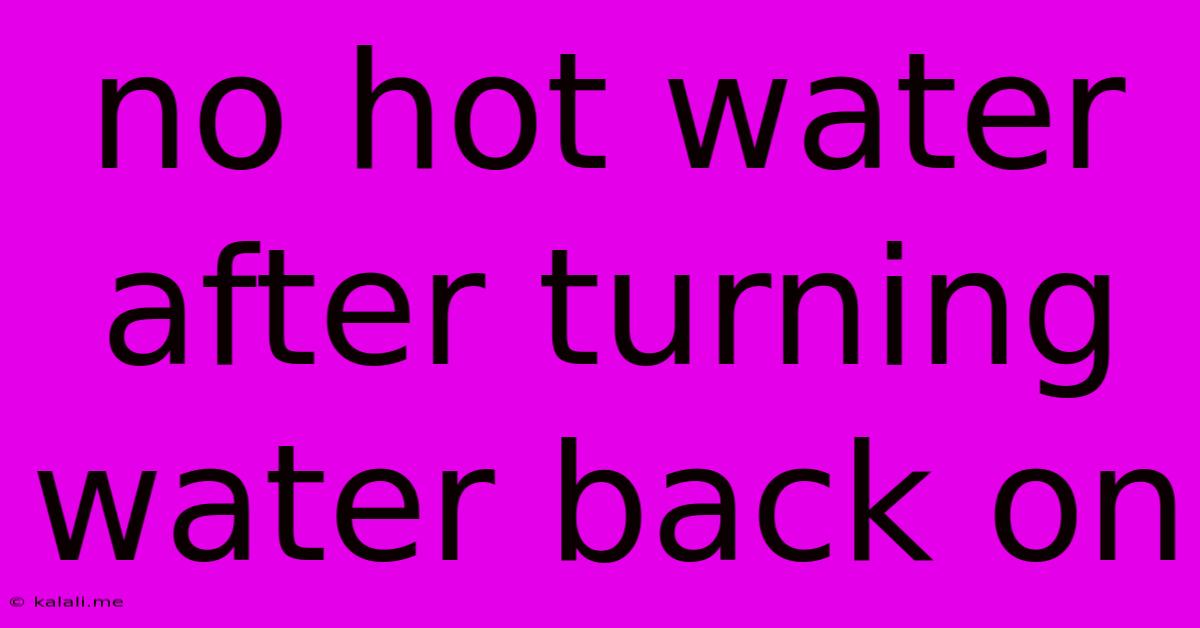No Hot Water After Turning Water Back On
Kalali
May 25, 2025 · 4 min read

Table of Contents
No Hot Water After Turning Water Back On: Troubleshooting Guide
Meta Description: Experiencing no hot water after restoring your water supply? This comprehensive guide explores common causes, from simple fixes to more complex issues, helping you get your hot water back on track quickly.
Have you ever turned your water back on after a repair, outage, or simply a period of non-use, only to find yourself facing a chilling surprise – no hot water? This frustrating problem is more common than you think, and while it can be alarming, it's often solvable with a bit of troubleshooting. This guide will walk you through the most likely culprits and how to address them.
Understanding Your Hot Water System
Before diving into troubleshooting, it's crucial to understand the basics of your hot water system. The type of system you have – tankless (on-demand) or tank-based – significantly impacts the potential causes of your problem.
- Tank-Based Systems: These systems heat and store water in a large tank. Issues often relate to the tank itself, the heating element, the thermostat, or the gas supply (if applicable).
- Tankless Systems: These systems heat water on demand, eliminating the need for a storage tank. Problems tend to be related to gas supply, electricity, or internal components like flow sensors or heat exchangers.
Common Causes of No Hot Water After Water Restoration
Several factors can lead to this predicament. Let's explore the most prevalent ones:
1. Air in the Lines: This is the most frequent culprit, particularly after a water outage or significant plumbing work. Air trapped in the hot water pipes prevents hot water from reaching your taps.
- Solution: Open all hot water taps and let the water run for several minutes. This helps purge the air from the lines. If you have a tank-based system, you might hear gurgling sounds as the air escapes.
2. Sediment Buildup (Tank-Based Systems): Over time, sediment accumulates at the bottom of your water heater tank, reducing its efficiency and potentially obstructing water flow.
- Solution: Regularly flushing your tank can remove sediment. Consult your water heater's manual for specific instructions. This is a preventative measure that should be performed periodically, not just when you have a problem.
3. Thermostat Issues (Tank-Based Systems): A faulty thermostat might prevent the heating element from turning on or might be set to an incorrect temperature.
- Solution: Check the thermostat setting. If the temperature is too low, adjust it. If the thermostat itself is malfunctioning, you'll likely need to replace it.
4. Malfunctioning Heating Element (Tank-Based Systems): The heating element might burn out or become damaged, preventing water from being heated.
- Solution: This usually requires professional assistance. A plumber can diagnose the issue and replace the heating element if necessary.
5. Gas Supply Problems (Gas Water Heaters): If you have a gas water heater, ensure the gas supply is turned on and the pilot light is lit.
- Solution: Check your gas meter and ensure the gas supply valve to your water heater is open. If the pilot light is out, consult your water heater's manual for re-lighting instructions or call a qualified technician.
6. Electrical Problems (Electric Water Heaters): Check your circuit breaker or fuse box for tripped breakers or blown fuses that might be related to your water heater.
- Solution: Reset tripped breakers or replace blown fuses. If the problem persists, it could indicate a more serious electrical fault requiring professional attention.
7. Pressure Issues: Low water pressure can sometimes affect hot water delivery.
- Solution: Check your main water supply and any individual shut-off valves leading to your water heater.
8. Other Component Failures (Tankless and Tank Systems): More complex issues like failed pumps, flow sensors, or heat exchangers (especially in tankless systems) often require professional diagnosis and repair.
When to Call a Plumber
If the simple troubleshooting steps above don't resolve your no-hot-water issue, it's best to call a qualified plumber. Problems like a faulty heating element, gas leaks, or electrical faults should always be addressed by a professional to ensure your safety. Don't attempt complex repairs yourself unless you have the necessary experience and expertise.
By systematically working through these potential causes, you should be able to identify and resolve the source of your hot water woes and restore comfortable warmth to your home. Remember, safety is paramount; don't hesitate to call a professional if you're unsure about any aspect of the troubleshooting process.
Latest Posts
Latest Posts
-
What Does Es Mean In Spanish
May 25, 2025
-
Cardinality Of The Sierpinski Triangle Is Not Countable
May 25, 2025
-
How To Remove A Garbage Disposal
May 25, 2025
-
Exclide Specific Type Of File Search From Spotlight
May 25, 2025
-
How To Wire A Switch To A Light
May 25, 2025
Related Post
Thank you for visiting our website which covers about No Hot Water After Turning Water Back On . We hope the information provided has been useful to you. Feel free to contact us if you have any questions or need further assistance. See you next time and don't miss to bookmark.